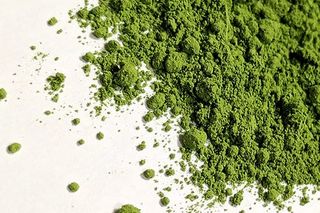
Untrending: What Are The Health Benefits of Matcha, Really?
An investigation of the green powder that has taken over the world. And my tiramisu.

In Untrending, we side-eye the latest fads so we know what we’re getting ourselves into — and what (if anything) we’re getting out of them.
A few weeks ago, I had just finished a lovely dinner out, and was eagerly awaiting my dessert — a velvety tiramisu that I ordered as soon as I saw it on the menu. In the dim light, with much fanfare, it was set down before me.
It was lime green — which is one shade too close to Soylent Green, thanks.
I had somehow missed on the menu that this particular tiramisu was dusted in the bright green powder — and power — of matcha.
Matcha — finely ground tea leaves that have been grown in the shade, on the gently rolling slopes around Uji and Nishio, Japan — has taken over not only tiramisu, but the world. Traditionally served as a drink, frothed with boiling water, matcha is now found in lipsticks, in croissants, in beer and in just about every other item that never deserved to be virulently chartreuse. It is so touted for the health benefits of its antioxidant properties, that it earned the Japanese economy 12.2 billion yen in exports last year.
But the health benefits of matcha green tea are unproven. Antioxidants are compounds that inhibit the process of oxidation, a natural reaction in the body, but one that produces free radicals — molecules that damage cells and contribute to illness and aging. Antioxidants, therefore, have captured public imagination as a way to maintain health — but they have little clinical backing. Matcha contains high quantities of one particularly promising antioxidant: epigallocatechin-3-gallate, or, EGCG. In laboratory tests of cell cultures and animals, ECGC treatments appear to inhibit tumor growth. But even as researchers call this promising, they warn findings are not directly translatable to humans, and much more research is needed.
You could take a ‘why not?’ approach to matcha, and guzzle it anyway in hopes that it does work in preventing serious diseases. Except, there may well be a point beyond which drinking green teas, like matcha, becomes dangerous. First, other antioxidants like beta carotene and vitamin E, which had been seen as promising avenues for cancer prevention and treatment, have been revealed actually to increase cancer risk in high doses, by protecting cancer cells as well as normal human cells from the same damage by free radicals.
Additionally, high doses of EGCG have been known to cause liver damage known as hepatotoxicity; in 2015, a 16-year-old reportedly developed hepatotoxicity after drinking three cups of Chinese green tea each day for several months.
Of course, that incident could be due not (only) to the green tea itself, but to another risk related to matcha: dangerous knock-offs. True matcha is produced in Japan, but as the green tea powder has surged in popularity, Chinese knock-offs have flooded the international market. Chinese matcha tea takes shortcuts in production that make it cheaper — and more dangerous. Since the Chinese market is much less regulated than Japan’s, Chinese matcha is more prone to be contaminated with toxic chemicals; a 2013 Greenpeace study that tested 18 random samples of Chinese green teas found two out of every three contained banned pesticides.
No one is saying don’t drink matcha, but a lot of scientists are saying there’s no clear understanding of how, if at all, green teas like matcha prevent aging and serious diseases like cancer through their antioxidant content. Until that is better known, make sure your matcha is from Japan, is drunk in moderation, and stays far away from your tiramisu. (Seriously, why?)
Liesl Goecker is The Swaddle's managing editor.
Related


Study Peeks Into the Brain Wiring Behind Dyslexia
